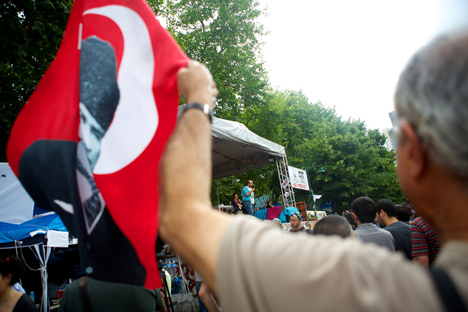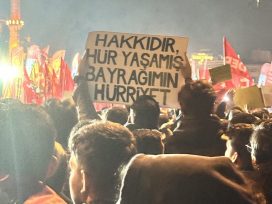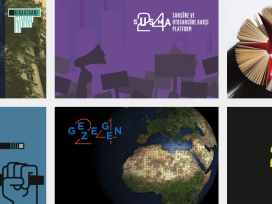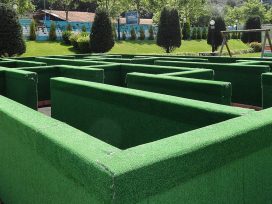The social insurgency that began in May 2013 with the “Gezi Park occupation” marked the entrance of a new political practice, never before seen in Turkish political life. It intersected with a molecular struggle and a minority politics. This linked to what thinkers such as Deleuze and Guattari and Foucault had institutionalized in the 1960s and 1970s; indeed, the overlap between this new political practice and the social and political theory I described in my books entitled Singular Thought, Michel Foucault-Power and Foci of Resistance, and Minor Policy made me especially excited. It bore great similarities to what I referred to as “new forms of struggle”. Not only liberal circles, but anti-capitalist Muslims too, recognized global capitalism was a movement that, given its ability to infiltrate the subject’s unconscious, could also infiltrate the Islamic bourgeoisie, who also profited from globalization. The link between conservatism and global capitalism began to become apparent. A rent lobby and a maximal profits lobby had already started to make themselves visible in opposition to the capitalist faction known as the interest rate lobby. The “keep constructing” discourse was valid at all times, but the maximal profits lobby, which turned urban memory upside down, had recently started to prevail.

Gezi Park. Photo: Gregg Carlstrom. Source:Flickr
The occupation of Gezi Park revealed the level of the fear that had cowed Turkey into submission for a period of more than thirty years, and which was suddenly overcome through the insurgency. In the absence of an economic crisis, a social crisis unfolded. The whole of Turkey learned that a crisis did not have to be exclusively economic. The events surrounding Gezi Park showed us the kind of media with which Turkey had learned to live. We encountered a concept referred to as “partisan media”. As a matter of fact, there was always media which was partisan, just as there were always columnists and journalists who resisted such media. After all, newspapers and television channels with such heterogeneous staff were perhaps so good as to conceal this fact from us. The slogan “Taksim is everywhere, resistance is everywhere” caused not only those living in Turkey but the whole world to realize how Turkish media functioned.
In the case of Gezi Park, dissemination practices and transversal struggle emerged as two poles that interacted with one another. As a “transversal struggle”, Gezi Park broke the established patterns of political life. But what does this mean? It combined roadblocks with strategies instead of directly coming up against governmental power. It came as a reminder that roadblocks are not based on any political rationality but are irrational and nothing but a defence and part of a movement that activated subjectivities. It showed that there were no suppressed psychoanalytical words in society, that the unconscious was not structured as a language, but only as a productive struggle. As such, language was fluent and slippery, but formed a clear escape path. It avoided applying violence against the state through language. On the contrary, it chose to abandon material and linguistic violence to the monopoly over both exercised by the state, government, governorate, ministry of internal affairs and general directorate of security. This event was not quite the straw that broke the camel’s back. But it did assume an attitude against the symbolic violence of consumerist society and the shopping malls upon which this society is founded. It was transversal, classless, non-hierarchical; it was both disorganized and rallying. Transversal struggle opposed not only to violence but also to a hierarchical social structure and to “us” – that is, those who parcelled out society and who tried to contain and integrate it. The transversal society searched for a new way out of the violence of an organization trying to reduce society to a bunch of consumers. It employed a devious device against bureaucracy. It used an element of surprise aimed against a system based on the opposition of political parties. For that reason, the government had difficulty understanding the protests. The government and the party political bureaucracies had to go on the defensive.
In the 1970s, students wanted to occupy the universities. The occupation of the Sorbonne in May 1968 assumed something of a mythical status in this respect and there was a similar movement involving university occupations in Turkey at the time too. However, this time the movement developed through the occupation of a park in the public realm and the struggle possessed a transversal transitivity. Unlike the labour unions, political parties or other organizations involved directly in governmental negotiations, the transversal struggle chose to expand and spread instead of being contained within such types of organizations, and forums were held in other parks. There was no preference for an autonomous, self-managed organization; instead it created a pragmatic strategy based on imagination. The transversal struggle did not therefore ever retreat but proceeded at all times. It sought new opportunities and found the weapons of new thinking and humour along the way. The creativity was revealed in pragmatism and process. Unlike those who advocate a pioneering policy towards the arts, it developed a transversality and expansiveness which did not capitalize on such a perspective. Those who said “It is now time to become conscious” committed themselves to a pragma and drew a line. The ways of struggling expanded through expression but not through conscious or political surrender. The attitude continued to reject the approaches of those who tried to transfer the struggle to labour unions, political parties, organizational hierarchies and so on. There was a reluctance, both to bear the political legacy of the past and to erase the social values that had merged with conservatism. There was agreement that conservatism should not be isolated: there would be no avant-garde. The transversal struggle was a response to a government that was pyramidal in form. In opposition to the politics linked to the top of the pyramid, the transversal struggle refuted the words of this politics by disseminating them. It showed how ridiculous, trivial and outdated such centricity was. It made us experience the fall of such a perspective. The transversal struggle sketched out the grounds as to why no oppressive government could in fact function. It revealed that an ideological perspective would damage not only politics but any and all movements as well. It introduced those who said, “They are ideological!” as ridiculous, and proved them to be so too. It impeded their functionality and proved that it was not ideological. It silently explained that it took action from a material perspective. And it reiterated how talkative those masses were, which were assumed to be silent. It provided evidence as to the kind of ideological basis upon which that which was called democratic functioned. It made us think over the regime of democracy. It made us feel how a hierarchical unity would injure the movement. It strongly underlined how important freedom of expression was and that democracy would function not with the vote of the majority within the election system but with freedom of expression. It once again reminded that the anti-fascist movement might cross our minds as well. It produced the practices of the women’s queer movement and showed how these function – masculine and macho violence aside – in each gender of society. It rejected all violence, whether material or symbolic. It demonstrated that politics was not the work of a technician but an affair of courage. It introduced how important it was to protect oneself from organizations run by technicians: a transversal struggle seems to be our “formation”.
What happened in Taksim?
Dissatisfaction over the political practices of the government and the power groups has been simmering for a long time and it crystalized in the Gezi Park issue. The Taksim pedestrianization project, the gentrification of Beyoglu, Inci Cake Shop, Emek Cinema House, 1 May and other similar events were all beginning to take their toll on people’s everyday lives. Legal weaknesses, murders of transsexuals, anti-war and conscientious objection movements, youths’ despair for their future, precarity in the business world: all these burst out in Gezi Park. A variety of influences intermingled in the occurrence of the events here. Feelings were swelling.
At present, the distinction between what is politic and what is vital has disappeared: we are living in accordance with the policy of everyday life. We are living in accordance with the feelings formed by those policies, which affect and hit our spirits and bodies not in an ideological but only a material way. Fear has become the device of a policy which functions through such emotional impacts. There is discomfort concerning material life and the future everywhere: Urban memory is disappearing, forests and trees are disappearing, traffic and urbanization are eradicating the middle and lower classes from the life-world. Within the economy of rent, crisis is perhaps not economic but it is excessively social. May no one tell us that there is no crisis! May no one say “Oh, we are all right!” and compare us to the western crisis, with Spain, Italy and Greece. The crisis is the same crisis. Fear is the crisis of the concern about the future; common crisis of the multitude living under control. There is no West or East nor South or North. Fear policy is roaming everywhere in a common, transversal, transitive way.
Crisis lies within the fear policy. Governments are incapable of acting. Police carry out their tasks in the form of violence, as if they do not have any other function. They have become police of defence but not of protection. There is anxiety and fear intended to envelop not only Taksim and Istanbul but the whole of Turkey. The peace process functions as part of this world of fear. We are facing a situation in which every one is afraid of one other. This was also the case during the military coup of 12 September. Every one was afraid of the other. Those who were afraid of the other within political polarizations buried politics in their discourses: “Communism is coming!”, “Fascism is coming!” and “Islam is coming!” In an article that deals with violence and post-politics, Zizek describes biopolitics as a case in which every one is afraid of his neighbour.
One wrote, “If the national anthem of a country starts with ‘Fear not!’, then there is fear in that country.” And courage in the face of fear was to be found in the Gezi Park resistance. If there were thousands of people there and if they resisted those who threatened their lives, it means that the challenge to fear began there. They resisted the post-politics of fear which threatens the future just like those in Madrid, in Athens, in Seattle and in Genoa. A resistance with fun, a resistance in a carnival atmosphere. This was not only resistance to neoliberalism and neo-fascism and neo-authoritativeness, but a movement against those anti-life powers which concern every one and which interfere with every one’s everyday life and against an attitude which wants to see every one ill and in mourning. It is the resistance of life to any type of approach such as liberal, neoliberal, statist, planning and so on.
Gezi Park micropolitics
Are we reaching the end of policies based upon political parties? The micropolitics of desire resists in accordance with feelings, effects and chance events. Let none of the parties –neither government nor opposition – try to take credit for this resistance. Despite overlaps, the great majority started to rise up and resist precisely because there was no true material party policy. Youths are placing their desires in the squares and streets and do not want their desires to be grasped by political parties. Of course, resistance in Taksim needs support, but they do not want to be captured and grasped by political parties.
Today, when one refers to desire, the desire of a collective expression is intended, but not that of a subject. We refer to the insurrection of “tiredness” against an event. This is not the indulgence or desire of an individual; if it were, then it might be a desire that could be grasped in its entirety by political parties. However, a collective process of individualization means facing desire. As in psychoanalysis, there is no desire in the suppressed self involved these events but, on the contrary, an explosion, a crystallisation appears when desire and suppression encounter the reality of a social realm.
Gezi Park stands before us not as a symbol or as a place where collective desire crystalizes but as a true area of struggle. However, political parties dwell upon the symbolic, regardless of where they come from. The symbolic is put to work in the transcendence of social reality by the political parties. And the youth and transversal, transitive form of struggling resists this: the youth are not only against the structure being erected in Taksim now. They are trying to protect their lives from being broken and restrained. They consider the violence of the police and the attitude of the government to be an insult committed against their collective life, which combines fun and resistance. They resist even more the self-indulgence of the government and take their collective desires to the streets. We can only understand the resistance movement through the micropolitics of desire.
Despite the macropolitics by which the political parties try to grasp desire, the youth are now after a micropolitics that has crystalized in many cities and which is a politics of desire. The desire that spontaneously organizes puts into operation a micropolitics against a bureaucratic neo-fascism. They proclaim – in the streets – their micro-desires and their minor being against state power, police power, government power, family power, the power of custom, linguistic power, power at schools, the power of centrality of bureaucratic political parties, the power of the phallus and the power of macho masculinity, and against the tiredness which all of the preceding stimulate. They try to respond to police violence with songs; all – those in the streets and those at home – make music and sing songs with the pots and coffee pots and those at home accompany those in the streets.
They thus challenge the government and opposition duality, which the government and political parties have established as a dichotomy. We are experiencing a collective micropolitical formation of the desire, which impedes the dichotomies that yield the same type of government. Against a macropolitics that organizes people around political slogans and against class dualities and against such theoretical dichotomies as bourgeois capital and working class, oppressors and the oppressed, employed and unemployed, youth and elderly, women and men, the micropolitics of desire that collectively overlaps with such distinctions as young, old, man, woman, employed or unemployed, employer or employee, crystalized in Gezi Park and Taksim. It drew not only the Turkish youth and elders but the whole world into a transversal resistance, a sphere of resistance from New York to Cologne, from Izmir to Adana and Antalya, from Ankara to Bursa.







